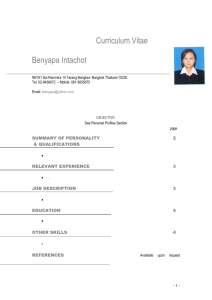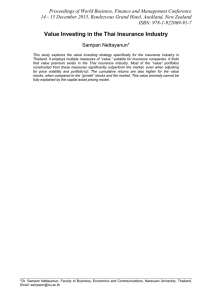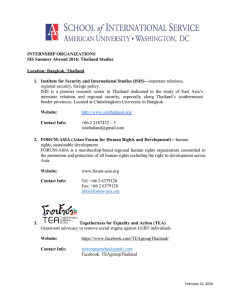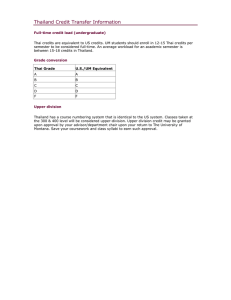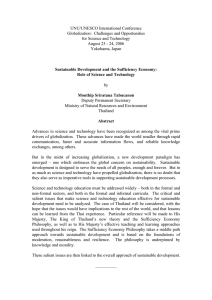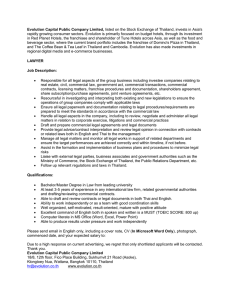Proceedings of 10th Global Business and Social Science Research Conference
advertisement
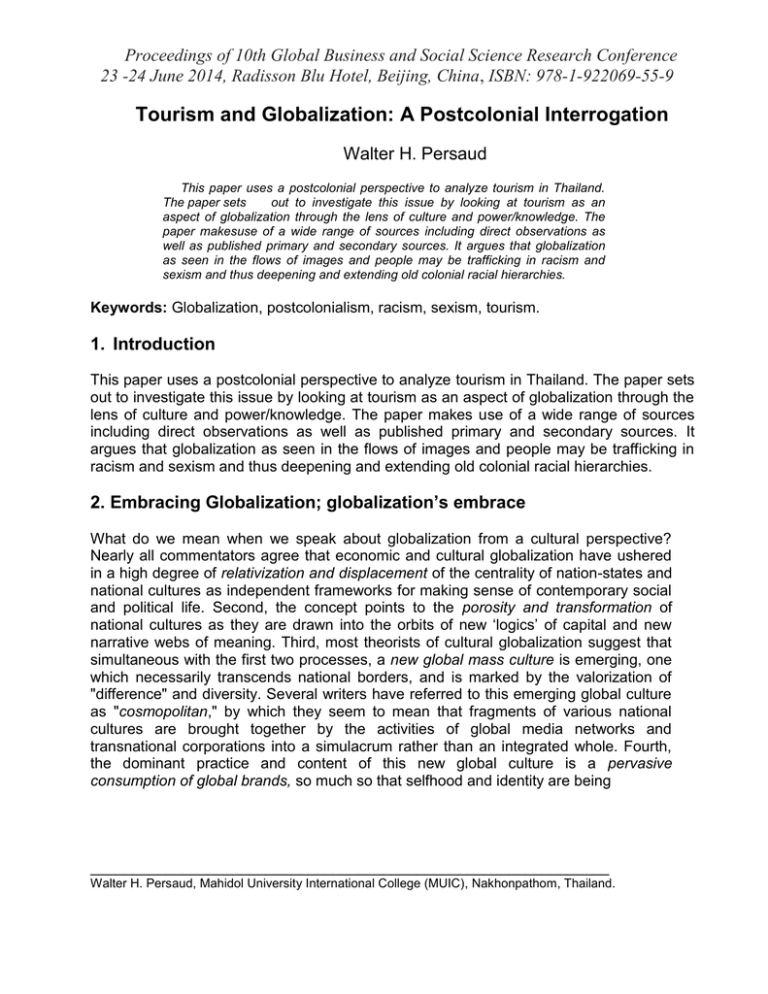
Proceedings of 10th Global Business and Social Science Research Conference 23 -24 June 2014, Radisson Blu Hotel, Beijing, China, ISBN: 978-1-922069-55-9 Tourism and Globalization: A Postcolonial Interrogation Walter H. Persaud This paper uses a postcolonial perspective to analyze tourism in Thailand. The paper sets out to investigate this issue by looking at tourism as an aspect of globalization through the lens of culture and power/knowledge. The paper makesuse of a wide range of sources including direct observations as well as published primary and secondary sources. It argues that globalization as seen in the flows of images and people may be trafficking in racism and sexism and thus deepening and extending old colonial racial hierarchies. Keywords: Globalization, postcolonialism, racism, sexism, tourism. 1. Introduction This paper uses a postcolonial perspective to analyze tourism in Thailand. The paper sets out to investigate this issue by looking at tourism as an aspect of globalization through the lens of culture and power/knowledge. The paper makes use of a wide range of sources including direct observations as well as published primary and secondary sources. It argues that globalization as seen in the flows of images and people may be trafficking in racism and sexism and thus deepening and extending old colonial racial hierarchies. 2. Embracing Globalization; globalization’s embrace What do we mean when we speak about globalization from a cultural perspective? Nearly all commentators agree that economic and cultural globalization have ushered in a high degree of relativization and displacement of the centrality of nation-states and national cultures as independent frameworks for making sense of contemporary social and political life. Second, the concept points to the porosity and transformation of national cultures as they are drawn into the orbits of new „logics‟ of capital and new narrative webs of meaning. Third, most theorists of cultural globalization suggest that simultaneous with the first two processes, a new global mass culture is emerging, one which necessarily transcends national borders, and is marked by the valorization of "difference" and diversity. Several writers have referred to this emerging global culture as "cosmopolitan," by which they seem to mean that fragments of various national cultures are brought together by the activities of global media networks and transnational corporations into a simulacrum rather than an integrated whole. Fourth, the dominant practice and content of this new global culture is a pervasive consumption of global brands, so much so that selfhood and identity are being ______________________________________________________________ Walter H. Persaud, Mahidol University International College (MUIC), Nakhonpathom, Thailand. Proceedings of 10th Global Business and Social Science Research Conference 23 -24 June 2014, Radisson Blu Hotel, Beijing, China, ISBN: 978-1-922069-55-9 redefined through the fact of consumption as much as by the brands consumed, with different writers arguing that modernist identities are being fractured, hybridized and/or deterritorialized. Fifth, theorizing the relationship of different aspects of cultural globalization to the remaking and/or transformation of identities has itself emerged as a site of much discussion and speculation. Finally, the process of cultural globalization has ushered in debates over the direction of cultural change, that is, the manner and degree of homogenization and/or indigenization of global symbols and processes as peoples, societies and cultures are drawn into their networks. Closely related to this final area of debate is the extent to which the various forms of globalization serve the neo-liberal agenda of the IMF, World Bank, WTO and G8 countries, otherwise known as the Washington consensus. 3. The Sexual economy of Tourism In some versions of cultural studies, hybrid and cosmopolitan identities are celebrated as having the potential to unsettle and displace the grand narratives of Western modernity and thus open new spaces for the articulation of post-racist/ post-sexist identities. However, in Southeast Asia, the Western-Asian partnership in modernity/globalization is structured by a common and extensive sexist and racist regime. This colonial pact is evident in Thailand‟s promotion of itself as a tourist paradise in stereotypical images of female subservience and friendliness. Thailand and other Southeast Asian countries enthusiastically participate in and fund their selfOrientalization, inviting and profiting from this global economy of racist and sexist attitudes, feelings, fantasy and reference (Said, 1978). In the global flows of languages, images, ideas and people, what we are witnessing in Southeast Asia today is indeed various forms of biological and cultural mixing as noted by several writers under the signs of hybridity and cosmopolitanism. But in the reception and indigenization of much of these flows, the content of the hybrid and cosmopolitan identities which they engender in Southeast Asia reinforces and extends old colonial hierarchies structured by the ideology of Western/ white supremacy, notwithstanding important differences between the colonial and postcolonial periods. In the latter period, Southeast Asians not only encourage and actively make the flows possible, but they also translate their meanings locally into old colonial racist and sexist stereotypes such as “white is right” (Bangkok Post, 2001, 2004; Wong, 2004). Arjun Appadurai perceptively notes that [i]t is this fertile ground of deterriorialization, in which money, commodities and persons are involved around the world, that the mediascapes and ideoscapes of the modern world find their fractured and fragmented counterpart. For the ideas and images produced by mass media often are only partial guides to the goods and experiences that deterriorialize populations transfer to one another. With direct relevance to Thailand, Appadurai goes on to say that: [t]hese tradegies of displacement could certainly be replayed in a more detailed analysis between the Japanese and German sex tours to Thailand and the tradegies of the sex trade in Bangkok, and in other loops which tie together Proceedings of 10th Global Business and Social Science Research Conference 23 -24 June 2014, Radisson Blu Hotel, Beijing, China, ISBN: 978-1-922069-55-9 fantasies about the other, the conveniences and seductions of travel, the economies of global trade and the brutal mobility fantasies that dominate gender politics in many parts of Asia and the world at large (Appadurai, 1990, p303). In short, contemporary globalization is glamorizing and trafficking in modernity‟s old racist and sexist categories, endowing with old passions and re-newed vigor. The manner in which private and state interests are actively at work in Thailand‟s selfOrientalization is vividly and directly displayed in a wide range of tourist promotion materials. For example, in their exceptional work tracing the intimate relationship between Thailand‟s “miracle” development and the sex tourism/ prostitution industry, Ryan Bishop and Lillian Robinson analyze a range of state and private sector tourist promotion brochures which invite tourists to Thailand for sex tourism. Among several others which the authors analyze is a 1995 brochure from the national airline, Thai Airways International, entitled “Thai Values: Incentive Travel to the Land of Smiles.” This brochure, which was directed at company executives, is brilliantly deconstructed for its racist and sexist messages. According to the authors, the brochure plays up Thai International‟s – and, by extension, the nation‟s – desire to serve this person. The CEO, in essence, plays the role of the colonial home officer pulling in profits from around the globe and rewarding his troops for their good performance by sending them for corporate R&R. The ways in which the colonized periphery services the cosmopolitan center are re-inscribed in the „values‟ this brochure touts, a wedding of international corporate business and full-service tourism (Bishop & Robinson, p.70-71). The authors go on to note that “each two-page spread stated a different theme or topic in boldface print.” These include: “Thai values make Thailand the ultimate incentive; So much for so little; Beauty and the beach …- all at bargain prices; Living values; The most affordable luxury in Asia; and All the pageantry in Thailand – at your command ” (Emphasis in the original) (Bishop and Robinson, p. 71). On the cover is a photograph of a Thai woman and a Western couple with the Thai woman “placing a jasmine garland around the man‟s neck…. The Thai woman seems to be pulling the man towards her with the garland, and he leans forward smiling broadly. The white male, white-collar traveler receives the hands-on attention of the female Thai servant” (Bishop & Robinson, p. 71). The authors then move on to the page entitled “Beauty and the Beach,” where, after a paragraph describing “tropical isles,” a single line states “This is Thailand,” beside which is shown “a Thai woman wading in crystal blue water up to her buttocks. Back to the camera and again faceless, this woman embodies the nation that will service deserving corporate functionaries. Throughout the brochure, we see women outnumbering men by four to one” (Bishop & Robinson, p. 71-72). That this brochure was directed at white males is clear not only from the graphic images described above but also from the line saying “This is Thailand.” This sentence, and a shortened form, TIT, is used by a Bangkok Post‟s weekly columnist, Bernard Trink, at the end of his summary of the weeks main events at the major prostitution/ go-go Proceedings of 10th Global Business and Social Science Research Conference 23 -24 June 2014, Radisson Blu Hotel, Beijing, China, ISBN: 978-1-922069-55-9 centers in Bangkok and around Thailand. In effect, Trink provides a weekly guide to sex tourism for his Western male audience, representing prostitution as Thailand and Thailand as prostitution with his closing statement “This is Thailand.” That Trink has been allowed to continue his column uncensored despite complaints from women and men of various nationalities and ethnicities points to the hegemonic normalisation of the sexualization and racialization of the nation. Anyone who returns from Thailand to a Western country is likely to encounter Thailand‟s sex economy as a point for discussion. In my own experience, many males who were aware of my overseas stay were eager to talk about Bangkok, and repeatedly, the first topic of discussion was Thai women. Very often the questions were explicitly about sex in Bangkok and sometimes it was accompanied with some friendly advice that I needed to be careful, otherwise I could contract AIDS. Interestingly, none of those I had spoken with had ever been to Thailand. Further, on my way here, as well as during my first few days in Bangkok, I repeatedly encountered the same topics and advice from males, both Western and Thai. 4. On Tour: One night in Bangkok This racist and sexist economy of desire can also be witnessed within one night of being in Bangkok. As soon as it begins to get dark, large numbers of white Western men can easily be seen walking purposefully about certain inner city sections of Sukhumvit and Silom Roads, sometimes in pairs, more often alone. On their way to their infamous destinations, they can be observed fending off repeated assaults on their private meditations on the nights plans as hawkers, taxi drivers, and paid sex touts armed with leaflets and photographs of half-naked Thai women and a few words of discernable English compete for a slice of the farang dollar (Cohen, 2001). “Hey falang. Where you go? Come, I show you Thai lady. Young, beautiful. You want?” “How much?” “Come. I show you first.” The risk is assessed. This one is no taker. The journey continues. In areas such as Patpong on Silom Road, Soi Cowboy at the Rachadapisek/ Sukhumvit Road intersection, Soi Nana on Sukhumvit Road and around the Malaysia Hotel off Rama IV Road, large numbers of ill-clad, dark-skinned girls can almost always be seen hanging around idly, rotating from table to table, clinging to the arms of white Western men, young, old, and not infrequently, retired. The same observation can be made at any of the touristic towns, such as Hat Yai, Pattaya, Phuket, Samui and around the night market in the northern city of Chiang Mai. On observing this scene around Bangkok for a few days when I first went to Thailand in 1993, two questions came to mind. First, what is the relationship between the representation of Thailand, and Thai women in particular, in tourist brochures to racism, sexism and prostitution there. Secondly, how did ordinary Thais feel about Westerners, sex tourism and prostitution. To investigate the second concern directly, I spoke with several second and third year students at Thammasat and Chulalongkorn University campuses. What was striking was that their views of the Western tourists I Proceedings of 10th Global Business and Social Science Research Conference 23 -24 June 2014, Radisson Blu Hotel, Beijing, China, ISBN: 978-1-922069-55-9 had observed and those of the tourists themselves were worlds apart. The students seemed certain that most tourists visited Thailand for its temples and beaches, because "they liked Thai people for their “friendliness”, and because “Thai women were beautiful." Unable or unwilling to see that what was passing for tourism promotion and tourism in Thailand was very often nothing less than invitations to and trips by Western and wealthy Asian males to purchase sexual services from Thai women, instead, the students complained that Longman's Dictionary had unfairly represented their country as a place with a massive prostitution industry and argued that, in fact, prostitution was quite minor in Thailand. Before leaving, I was asked what I thought of Thai food, Thai people and Thai women. For most Western men who “flow” into Thailand, this seems to be a land of cheap, exotic women, carefree living and nightlife, and beautiful beaches. The word flow is in quotation marks here to suggest an affinity with the concept of “global flows” suggested by Appadurai. As demonstrated in Alex Garland‟s The Beach and the Hollywood movie which was based on it, Thailand is a terrain on which boyhood war fantasies continue to run wild with stereotypical images of ex-Vietnam veterans telling adventurous war stories in poorly lit bars on the margins of the illicit, of young boys and attractive women available for all sorts of sexual fantasies, and of inept and corrupt government officials who could be bribed cheaply to do just about anything. Even though most of what is imagined never get beyond fantasy, these racist and sexist images of Thailand among Western peoples persist, and droves of white Western and Japanese tourists continue to come in search of sex, adventure, and sexual adventure (Bishop Ryan, 1998).i At various beaches and beach towns in Thailand, one can observe the texts of this violent colonial economy of desire in its most grotesque forms as brown skin girls fulfill the purchased fantasies of white men, many of whom are old enough to be their grandfathers, and as bare breasted white women make public displays of themselves by sunbathing topless in a country where such practices are strongly socially tabooed. 4. Conclusion This paper has looked at the way in which contemporary globalization continues to fashion a colonial form of modernity in Southeast Asia. In doing so, it has focused on how tourism in Thailand is connected to images of sexual adventures in that country. In theoretical terms, the paper raises the disturbing question of whether cosmopolitanism and hybridity are new umbrellas under which colonial fantasies are pursued. If this is true, cultural and postcolonial theorists need to develop new conceptual frameworks to unpack and unsettle these white privileges. Proceedings of 10th Global Business and Social Science Research Conference 23 -24 June 2014, Radisson Blu Hotel, Beijing, China, ISBN: 978-1-922069-55-9 References Appadurai, A. (1996). Modernity at Large: Cultural Dimensions of Globalization, Minneapolis: University of Minnesota Press. Appadurai, A. (1990).“Difference and Disjunction in the Global Economy.” In Mike Featherstone (ed). Global Culture: Nationalism, Globalization and Modernity, London: Sage Publications, pp. 293-310. Bangkok Post, (12 March 2001). “White is not Always Right ,” Bangkok Post, Your Money, p.8. Bangkok Post, (12 March, 2004). “Fair Fetish,” p. 15. Bhabha, H.K. (1994). The Location of Culture, London and New York: Routledge. Bishop R. and Robinson, L.S. (1998). Night Market: Sexual Cultures and the Thai Economic Miracle, London and New York: Routledge. Breckenridge, C.A., Pollack, S., Bhabha, H.K. Chakrabarty, D. eds. (2002). Cosmopolitanism, Durham and London: Duke University Press. Castells, M. (1996). The Rise of the Network Society, Oxford: Blackwell. Cohen, E. (2001). Thai Tourism: Hill tribes, Islands and Open-ended Prostitution, Bangkok: White Lotus Books. Dirlik, A. (1997). “The Postcolonial Aura: Third World Criticism in the Age of Global Capitalism.” In Anne McClintock, Aamir Mufti and Ella Shohat, eds., Dangerous Liaisons: Gender, Nation and Postcolonial Perspectives, Minneapolis: University of Minnesota Press, pp. 501-528. Dore, C. (2000). “The Rise and Fall of the Washington Consensus as a Paradigm for Developing Countries,” World Development, Vol. 28, No. 5, pp. 789-804. Featherstone, M., Lash S., and Robertson, R., eds. London: Sage Publications. (1995). Global Modernities, Friedman, J. (1994). Cultural Identity & Global Process, London: Sage Publications. Gaonker, D.P. ed. (2001). University Press. Alternative Modernities, Durham and London: Duke Giddens, A. (1990). The Consequences of Modernity, Cambridge, UK: Polity Press. Proceedings of 10th Global Business and Social Science Research Conference 23 -24 June 2014, Radisson Blu Hotel, Beijing, China, ISBN: 978-1-922069-55-9 Hannerz, U. (1997). “Scenarios for Peripheral Cultures.” In Anthony D. King, Culture, (ed.) Globalization and the World System: Contemporary Conditions for the Representation of Identity, Minneapolis: University of Minnesota Press, pp.107128. Harvey, D. (1989). The Condition of Postmodernity, Oxford: Blackwell. Held, D. and McGrew, A. eds. (2000). The Global Transformations Reader: An Introduction to the Globalization Debate, Cambridge, UK: Polity Press. Hirst, P. and Thompson, G. (1996). Globalization in Question, Cambridge, UK: Polity Press. Ohmae, K. (1994). The Borderless World: Power and Strategy in the Global Marketplace, London: HarperCollins. Ohmae,K. (1996). The End of the Nation State: The Rise of Regional Economics, London: HarperCollins. Ong, A. (1998). “Flexible Citizenship among Chinese Cosmopolitans.” In Bruce Robbins and Pheng Cheah, (eds.) Cosmopolitics: Thinking and Feeling Beyond the Nation, Minneapolis: University of Minnesota Press, pp. 132-162. Pieterse, J.N. (1995). “Globalization and Hybridity.” In Mike Featherstone, Scott Lash and Roland Robertson, (eds.) Global Modernities, London: SAGE Publications, pp. 45-68. Robbins, B. and Cheah, P. eds. (1998). Cosmopolitics: Thinking and Feeling Beyond the Nation, Minneapolis: University of Minnesota Press. Roland Robertson, Globalization: Social Theory and Global Culture, London: Sage Publications, 1992. Tehranian, M. (1999). Global Communication and World Politics, London: Lynne Rienner Publishers. Tomlinson, J. (1999). Globalization and Culture, Chicago: The University of Chicago Press. Wong, S. (28 March 2004 ). “White‟s Right in Asia,” Outlook, Bangkok Post, p. 5. Young, R.J. (1995). Colonial Desire: Hybridity in Theory, Culture and Race, London and New York: Routledge.
